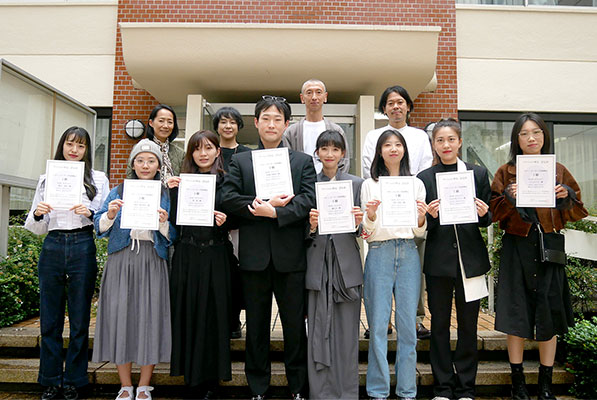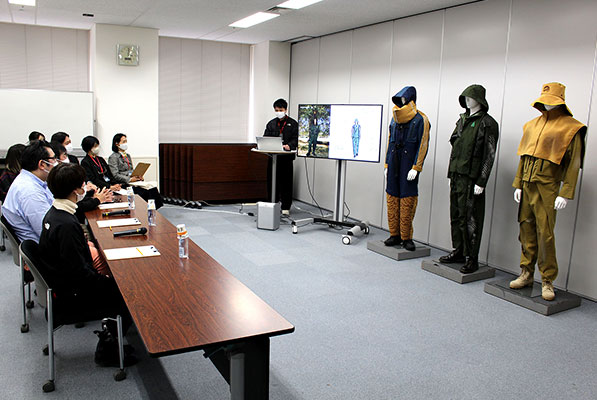Fashion Technology Course
Learn technologies in a wide scope so as to become a
global fashion modelist.

Create fashion with the ability to “create”, “apply”, and “communicate”.
FINAL WORK

Aiming to develop design utilizing technologies for commercialization, we conduct research, trial production, verification, portfolio production, exhibition, and fashion show. Besides, we also collaborate with various corporates actively.
15th BFGU FW: Exhibition 15th BFGU FW: Fashion ShowApproach to apparel 3DCAD
15th BFGU FW: 3DCADPass in Level 1 Pattern Making Examination
Collaborative pattern-making research project between Goldwin Inc. & BFGU
Business: Designer brands, Fashion apparel makers, Sewing factories
Occupations: Modelist, Patternmaker, Production planner
■ Employment Situation
・Alumni Careers(Japanese page)
Curriculum
1st year main classes
Basic Research & Collection

Through the research activities of first setting a research topic, conducting surveys and verification, then creating a prototype, works, and portfolios, finally presenting the result, students are able to deepen their knowledge, acquire skills, and by equipped with techniques about materials, pattern making, processing, and sewing all in line with their research themes.
Fashion Technology (Practical) I

Through the creation of original designs based on the utilization of the knowledge and techniques acquired in “Fashion Technology (Theory) I”, students are able to acquire pattern making technologies to tackle different designs. By studying theories and having practical trainings, students can acquire basic knowledge and skills as modelists.
Creative Thinking
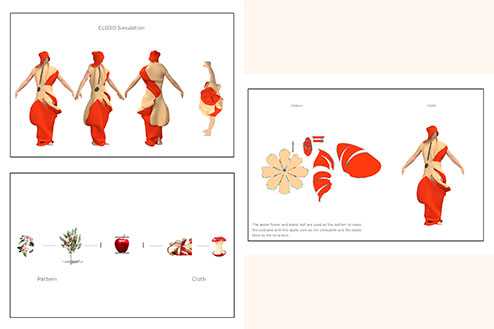
Learning how designers think and create ideas. The course aims t o improve “observation/ insight”, “problem-locating ability”, “creativity”, and “editing ability” that enable students to establish their own business concepts without being limited by the conventional framework.
2nd year main classes
Final Research & collection

Based on the theme of developing design into commercialization utilizing technologies, students create their works and portfolios by researching, prototyping, and verifying and finally presenting the results at exhibitions and fashion shows. Students are also able to acquire problem-solving skills through various independent research activities.
Fashion Technology (Practical) II
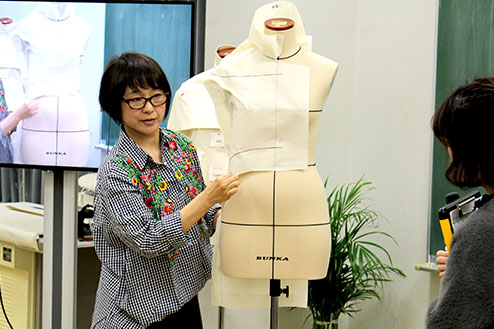
Learning about the details of practical tasks in the production process through the theories of box drafting from “Fashion Technology (Theory) II”. In the course, students are going to plan their imaginary brands specializing in technologies (materials, patterns, and sewing) in groups, discuss brands and products consumers ask for, and create works for commercialization.
Production Techniques II
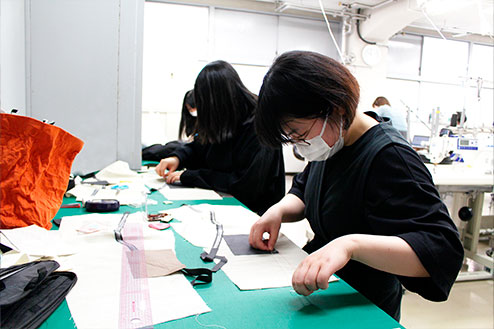
Learning how to make and sew haircloth patterns through making haircloth jackets. Students learn about techniques of creating industrial patterns taking into consideration the consistency between materials and sewing.
Curriculum composition
The curriculum of our fashion technology courses is classified and organized by “the ability to create”, “the ability to apply”, and “ability to communicate” so students are able to acquire knowledge, techniques, and ideas. They are able to learn technologies from a wide range of perspectives under the guidance of our academic staff from various fields.
*The subjects below may change.
FIRST YEAR SUBJECT
- [Required]
- Basic Research & Collection
Through the research activities of first setting a research topic, conducting surveys and verification, then creating a prototype, works, and portfolios, finally presenting the result, students are able to deepen their knowledge, techniques about materials. - Fashion Technology (Theory) I
Through pattern-making theories, we aim to have students understand 3D composition by 2D drawings and acquire the knowledge and techniques of design and production for garment design. - Fashion Technology (Practical) I
Through the creation of original designs based on the utilization of the knowledge and techniques acquired in “Fashion Technology (Theory) I”, students are able to acquire pattern making technologies to tackle different designs. - Fashion Business Methods (Practical)
Establish apparel brands in groups formed from all three courses utilizing knowledge acquired from various courses for constituting simulations of apparel manufacturing wholesalers. - Apparel 3D CAD I
The goal is to become able to perform basic digital operation in the 3D CAD software “CLO Enterprise”. - Apparel 3D CAD II
Learning applied operations based on the fundamental operations learnt in “Apparel 3D CAD I” and utilizing all these skills on the practical level. - Apparel CAD Pattern Making
Students are able to learn the fundamental operations of CREACOMPO II and understand the flow of efficient industrial design and the operation in production systems in the fashion industry. - Apparel & Textiles (Practical)
Learn the basic knowledge and traditional Japanese dyeing techniques to fuse textiles with creative design expressions. - Apparel Ergonomics
Attaining the ability to grasp the conditions, factors, and thus various relationships between body shape and garment design in a systematic manner. Students are learn about the relationship between the human body and patterns in static and dynamic movements. - Internship Program in Technology
The objective is to deepen students’ understanding of works, corporates, industry, and society through work experience taking their future career into consideration. - Creative Thinking
Learning how designers think and create ideas. - Sustainable Fashion I
Learning the basics about sustainability in the fashion industry. - Sustainable Fashion II
Sstudents are able to sort out various current issues in the fashion industry, and discover more advanced problems at different stages, as well as solutions and models for future development. - Characteristics / Applications of Materials
Students are able to learn how to select and process materials for the creation of works and learn how to make use of various processing equipment and how to create data. - Materials Theory
Students are able to understand the fundamental features of materials and textiles in apparel and fashion products. - Textile Design
Learning theories, techniques, and processes of textiles. - Product Planning for Designer Brands
Students are able to understand how to plan products from the relationship among the three important elements- design (items), customer (people), and experience value (things), and acquire the ability to visualize brand design and product planning. - Fashion Illustration
Through the exploration of unique expressions for student’s individual design themes, ideas, as well as the learning of the expression techniques, students are able to show their own originality. - Digital Fashion Illustration
Students are able to understand the composition of apparel items as commercial materials, as well as manufacturing raw materials and processes so as to acquire techniques to create illustrations using graphic software (Illustrator). - Draping I
Through basic jackets, students learn how to make use of the functionalities of jackets, how to strike a balance, and some basic draping technique. - Knitting CAD I
Through knit CAD trainings, students are going to learn the basics of industrial flat knits in line with the actual workflow. - Knitting CAD II
Understand knit programming, knit pattern making, knit design, and specification creation using knit CAD through practical training with knit CAD and computer flat knitting machines. - Technical Fabrics (Practical)
Understanding the design, patterns, sewing specifications, and functionalities of outdoor wears and sportswear through market research and special lectures. - Aesthetics
Get to know various ancient and modern concepts of beauty and artworks for the application to fashion creation. - AI, Metaverse & Fashion
Cultivate the foundation for the utilization of AI fashion data and the ability to create a new fashion industry using “Metaverse”. - Spoken English for Fashion
The course aims to improve the general English proficiency of students as future creators to fly up high in the international market. - Production Techniques I
Understanding garment structure theoretically and systematically through pattern making of men’s items and dismantling ready-made jackets. - Sewing Basics
Through sewing trainings using production equipment from garment factories, students are able to understand garment structure, main points in the manufacturing and the sewing processes for various types of garment. - Luxury Clothes-making Methods
Through lectures related to high end clothing, trainings about corset production, and draping trainings, students are able to acquire practical technical skills based on solid knowledge.
[Elective]
FINAL YEAR SUBJECT
- [Required]
- Final Research & Collection
Based on the theme of developing design into commercialization utilizing technologies, students create their works and portfolios by researching, prototyping, and verifying and finally presenting the results at exhibitions and fashion shows. - Fashion Technology (Theory) II
Students are able to study the theories of en closed drafting (men’s & ladies’), industrial pattern creation considering sewing specifications, and the development of designs through the use of existing patterns. - Fashion Technology (Practical) II
Learning about the details of practical tasks in the production process through the theories of box drafting from “Fashion Technology (Theory) II”. - Global Business Management
The course aims to cultivate students’ ability to formulate global business development plans by understanding the structure and market, along with acquiring practical knowledge with high regional expertise, and trends of fashion business in the world. - Computerized Knitting
Through trainings and work production using computer flat knitting machines, students are able to understand the features of flat knitting and learn how to design for the fashion industry. - Intellectual Property Management
The course focuses on the mechanism of intellectual property protection, especially brand (trademark) and design (Industrial design). - Draping II
Based on the basic draping skills learned in “Draping I” for the coordination of creating first pattern considering industrial sewing in drafting, the course shapes idea under various themes for molding through partial sewing. - Launching a Fashion Brand (Practical)
Students are able to acquire the necessary know-how such as business management and analysis for their business start-up plans with their own original colors. - Production Techniques II
Through the production of wool-core tailored jackets, students will master the techniques of wool-core patternmaking and the creation of industrial patterns that take into account the consistency of materials and sewing.
[Elective]



